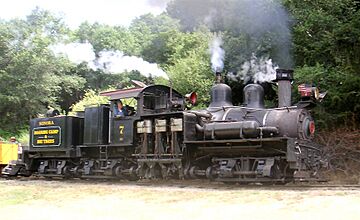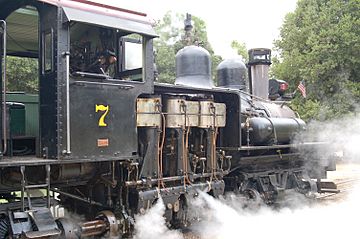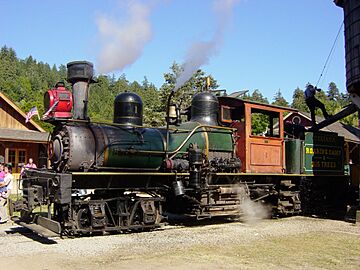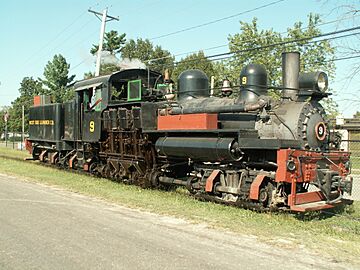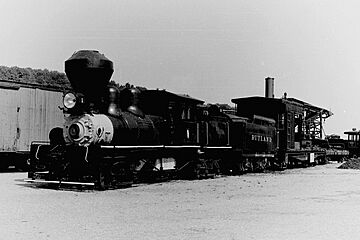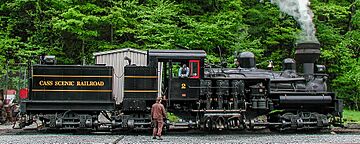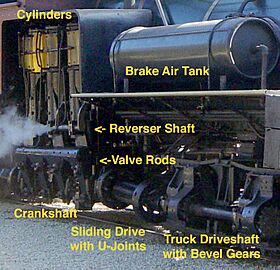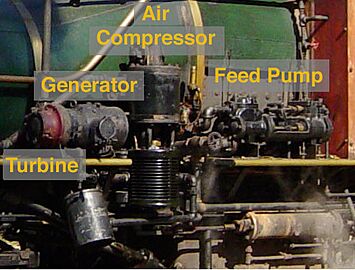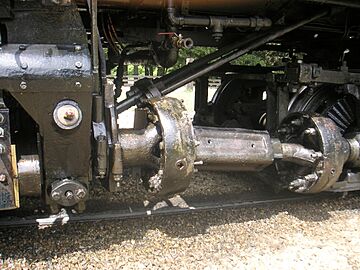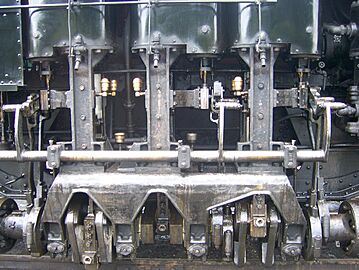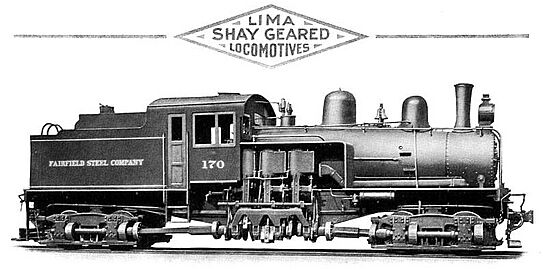Shay locomotive facts for kids
The Shay locomotive is a special type of steam locomotive that uses gears to move. It was mostly used in North America. These powerful engines were invented by Ephraim Shay. They became famous for being able to work well on rough or steep rail tracks, especially for moving logs and minerals.
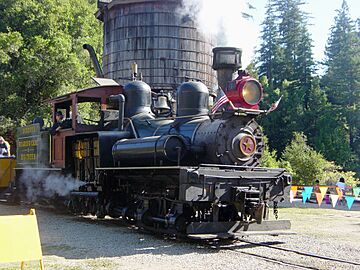
Contents
How the Shay Locomotive Was Developed
Ephraim Shay (1839–1916) was an inventor from Michigan. He was a schoolteacher, a logger, and even owned a railway.
In the 1860s, Shay worked as a logger. He needed a better way to move logs from the forest to the sawmill. Back then, logs were often moved on sleds in winter snow.
In 1875, he built his own small railway with wooden tracks. This allowed him to move logs all year round. Two years later, he had an idea for a new type of engine.
Shay's First Ideas
Shay imagined an engine sitting on a flat railcar. It would have a boiler, gears, and wheel sets that could turn. His first engine had two cylinders. The front wheels could swivel, but the back ones were fixed.
He first tried a chain to connect the engine to the wheels. This didn't work well. Then he tried a belt drive, but that also wasn't practical.
Patents and Production
Shay got a patent for his basic idea in 1881. This meant his invention was protected by law. He later patented an improved geared wheel set in 1901.
The Lima Locomotive Works in Lima, Ohio, built Shay's first engine in 1880. At first, Lima wasn't very interested. But thanks to John Carnes, they decided to build more. This led to the classic Shay design we know today.
Early Shays built before 1884 were smaller. They weighed about 10 to 15 short tons and had two cylinders. In 1884, Lima built the first Shay with three cylinders (called Class B). In 1885, they made the first Shay with three sets of wheels (called Class C).
By 1903, Lima built a huge 4-truck (Class D) Shay. It weighed 140 short tons. This was one of the heaviest locomotives of its kind. It was built for a railway in New Mexico that had steep hills and winding tracks.
Other companies also started making similar geared locomotives after Shay's patents ran out. One famous company was Willamette Iron and Steel Works in Portland, Oregon. Their engines were known as Willamette locomotives.
How Shay Locomotives Work
Shay locomotives were very useful for many jobs. They were used in factories, quarries, mines, and especially for logging. They were also good for switching cars in busy rail yards.
These engines were designed to handle "steep grades" (hills) and "uneven track." They could even run on tracks that were too light for regular locomotives.
Unique Design Features
Shay locomotives had their fire-tube boilers placed a bit to the left. This made space for the engine, which was mounted vertically on the right side. This engine had two or three cylinders.
Long drive shafts connected the engine's crankshaft to the wheels. These shafts had special joints that allowed them to bend and slide. This was important because the wheel sets could swivel under the locomotive. Each axle was driven by its own bevel gear.
One of the biggest strengths of Shay engines was that all their wheels were powered. This included the wheels under the tender (the car that carries fuel and water). This meant all the locomotive's weight helped it pull loads.
Shay locomotives were sometimes called sidewinders because their drive shafts were on the side. Most were built for use in the United States. However, many were also sent to other countries around the world.
Types of Shay Locomotives
About 2,770 Shay locomotives were built by Lima between 1878 and 1945. They came in four main types, called classes. Their weight ranged from 6 to 160 short tons.
- Class A: These had two cylinders and two sets of wheels. They weighed between 6 and 24 short tons.
- Class B: These had three cylinders and two sets of wheels. They weighed between 10 and 60 short tons.
- Class C: These had three cylinders and three sets of wheels. They weighed between 40 and 160 short tons.
- Class D: These had three cylinders and four sets of wheels. They weighed between 100 and 150 short tons. These were not more powerful than Class C, but they could carry more fuel and water. This helped them grip the tracks better.
Surviving Shay Locomotives
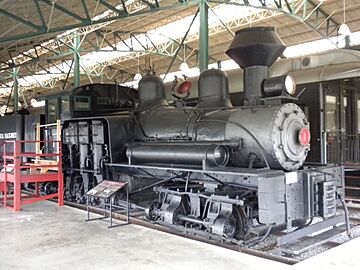
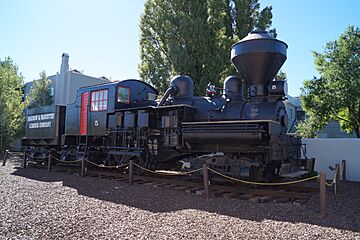
Today, 115 Shay locomotives still exist. Some are even still running! Here are a few examples:
- The oldest surviving Shay, built in 1884, is on display at Turtle Bay Exploration Park in Redding, California.
- The oldest working Shay is at the Cass Scenic Railroad State Park in West Virginia. It's called No. 5 and has been running on its original tracks since 1905.
- The Yosemite Lumber Company's #4 Shay is partly restored. You can see it at the Sierra Nevada Logging Museum in Arnold, California.
- Anaconda Copper Mining Shay No. 5 is on display by the Grand Canyon Hotel in Williams, Arizona.
- The Allen County Museum in Lima, Ohio, has a two-truck Shay. It was used in a local quarry and is close to where it was built in 1925.
- The Roaring Camp & Big Trees Narrow Gauge Railroad in Felton, California, operates two Shays: No. 1 Dixiana and No. 7 Sonora.
- Railtown 1897 State Historic Park in California has a Class C Shay, Sierra Railroad No. 2. It sometimes pulls excursion trains.
- The Colorado Railroad Museum has two Shays, Nos. 12 and 14. They used to run on the Georgetown Loop Railroad.
- The New Jersey Museum of Transportation is restoring Ely-Thomas Lumber Company No. 6.
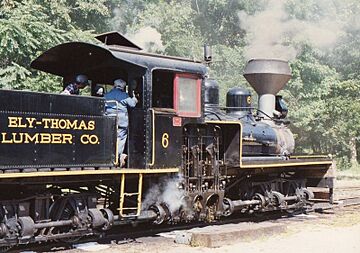
- The Yosemite Mountain Sugar Pine Railroad operates two former West Side Lumber Company Shays, Nos. 10 and 15.
- The Canada Science and Technology Museum has one working Shay. It was built from parts of two different locomotives.
- Graham County Railroad No. 1925 is at the North Carolina Transportation Museum. It is known as the fastest Shay ever recorded.
- Serial number 3345, a Class C Shay, was the last narrow gauge Shay built. It was damaged in a fire but was rebuilt and runs again at the Hesston Steam Museum.
- West Side Lumber Company No. 9 is owned by the Midwest Central Railroad. It also ran at the Georgetown Loop Railroad for several years.
- The Illinois Railway Museum has a three-truck Shay built in 1929.
- Meadow River Lumber Co. No.1 is at the Steamtown National Historic Site in Scranton, Pennsylvania.
- The Cass Scenic Railroad State Park has several Shays, including Class C No. 6. This was the last Shay ever made in 1945. It is also the largest surviving Shay.
- The Alishan Forest Railway in Taiwan has several Shays. Four of them are still working.
- A Class B Shay, No. 8 "Livingston Lansing," is on display at the Railway Historical Society of Northern New York museum.
- Three Class B Shays are at the BC Forest Discovery Centre in Duncan, British Columbia.
- Goodman Lumber Company No. 9 is on display at the Mid-Continent Railway Museum in North Freedom, Wisconsin.
- The Longview Public Library in Longview, Washington, has a fully restored Shay on its grounds.
- Shop number 2769, built in 1914, is on display in Columbia Falls, Montana.
- One Class C Shay is shown at Buenavista railway station in Mexico City.
- Abitibi Power and Paper Co. Shay No. 70 is in a park in Iroquois Falls, Canada.
- The Davis-Aken Lumber Company #2 Shay is on display at the Pennsylvania Lumber Museum.
- Lopez Sugar Corporation No. 10 is the only known Shay in the island of Negros in the Philippines.
- The Woodstock Lumber Co. Class B Shay No. 5 is owned by Clark's Bears in Lincoln, New Hampshire.
Images for kids
-
Cass Scenic Railroad ID photo
-
Engine of Shay locomotive built by Lima Locomotive Works (s/n 3320 of 1928). Locomotive is still in operation in Cass Scenic Railroad State Park as Cass Scenic No. 2


